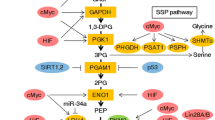Abstract
1-14C-Acetic, 1-14C-palmitic, or 1-14C-stearic acid was incubated with minimal deviation hepatoma 7288C cells grown in culture to assess: de novo fatty acid synthesis, oxidation, desaturation, and elongation of saturated fatty acids, as well as the ability of media fatty acids to serve as precursors of cellular glycerolipids. Distribution of radioactivity in the individual lipid classes and the various fatty acids of triglyceride, phosphatidyl choline, and phosphatidyl ethanolamine was determined. The radioactivity among the monoenoic acid isomers derived from triglyceride, phosphatidyl choline, and phosphatidyl ethanolamine was analyzed by reductive ozonolysis. Only small amounts of the labeled substrates were oxidized to carbon dioxide. Except for labeled stearic acid, which also was incorporated heavily into phosphatidyl inositol and phosphatidyl serine, most radioactivity was recovered in triglyceride, phosphatidyl choline, and phosphatidyl ethanolamine. Synthesis of cholesterol and long chain fatty acids from labeled acetic acid demonstrated that these cells can perform de novo synthesis of fatty acids and cholesterol. Both labeled palmitic and stearic acids were desaturated to the corresponding Δ9 monoenes, and palmitic and palmitoleic acids were elongated. The hexadecenoic acid fraction isolated from triglyceride, phosphatidyl choline, and phosphatidyl ethanolamine, when acetic or palmitic acid was the labeled substrate, showed that greater than 70% of the labeled acids were the Δ9 isomer. Radioactivity of the octadecenoic acid fraction derived from labeled acetic or palmitic acids was nearly equally divided between the Δ9 isomer, oleic acid, and the Δ11 isomer, vaccenic acid. Desaturation of labeled stearic acid produced only oleic acid. These data demonstrate that the biosynthesis of vaccenic acid in these cultured neoplastic cells proceeds via the elongation of palmitoleic acid. The relatively high level of vaccenic acid synthesis in these cells suggests that the reported elevation of “oleic acid” in many neoplasms may result from increased concentration of vaccenic acid.
Similar content being viewed by others
References
Wood, R., Lipids 8:690 (1973).
Wiegand, R.D., and R. Wood, Lipids 9:141 (1974).
Watson, J.A., in “Tumor Lipids: Biochemistry and Metabolism,” Edited by Randall Wood, AOCS, Champaign, Ill., 1973, p. 34.
Avigan, J., C.D. Williams, and J.P. Blass, Biochim. Biophys. Acta 125:226 (1966).
Bligh, E.G., and W.J. Dyer, Can. J. Biochem. Physiol. 37:911 (1959).
Bergstrom, B., Acta Physiol. Scand. 25:101 (1952).
Beroza, M., and B.A. Bierl, Anal. Chem. 39:1131 (1967).
Wood, R., and R. Reiser, JAOCS 42:159 (1965).
Wood, R., and K. Healy, J. Biol. Chem. 245:2640 (1970).
Wood, R., and J. Falch, Lipids 8:702 (1973).
Wood, R., and J. Falch, Ibid. 9:979 (1974).
Holloway, P.W., and S.J. Wakil, J. Biol. Chem. 239:2489 (1964).
Elovson, J., Biochim. Biophys. Acta 106:291 (1965).
Weinhouse, S., J. Langan, J.A. Shatton, and H.P. Morris, in “Tumor Lipids: Biochemistry and Metabolism,” Edited by Randall Wood, AOCS, Champaign, Ill., 1973, p. 4.
Sabine, J.R., Ibid. p.21.
Watson, J.A., E.S. Kirsten, and J.B. Quint, Fed. Proc. 33:1573 (1974).
Geyer, R.P., in “Lipid Metabolism in Tissue Culture Cells,” Edited by G.H. Rothblat and D. Kritchevsky, Monograph 6, Wistar Institute Symposium, Wistar Press, Philadelphia, Pa., 1967, p. 33.
Moskowitz, M.S., Ibid. in “, p. 49.
Mackenzie, C.G., J.B. Mackenzie, and O.K. Reiss, Ibid. in “, p. 63.
Bailey, J.M., B.V. Howard, and S.G. Tillman, J. Biol. Chem. 248:1240 (1973).
Stoffel, W., and A. Scheid, Z. Physiol. Chem. 348:205 (1967).
Spector, A.A., in “Growth, Nutrition, and Metabolism of Cells in Culture,” Vol. 1, Eidited by G.H. Rothblat and V.J. Cristofalo, Academic Press, New York, N.Y., 1972, p. 257.
Wood, R., J. Falch, and R.D. Wiegand, Lipids 9:987 (1974).
Ruggieri, S., and A. Fallani, in “Tumor Lipids: Biochemistry and Metabolism,” Edited by Randall Wood, AOCS, Champaign, Ill., 1973, p. 89.
Bergelson, L.D., and E.V. Dyatlovitskaya, Ibid. in “, p. 111.
van Hoeven, R.P., and P. Emmelot, Ibid. in “, p. 126.
Author information
Authors and Affiliations
About this article
Cite this article
Wiegand, R.D., Wood, R. Lipids of cultured hepatoma cells: VI. Glycerolipid and monoenoic fatty acid biosynthesis in minimal deviation hepatoma 7288C. Lipids 10, 194–201 (1975). https://doi.org/10.1007/BF02534159
Received:
Issue Date:
DOI: https://doi.org/10.1007/BF02534159




